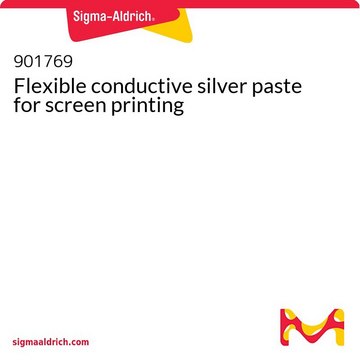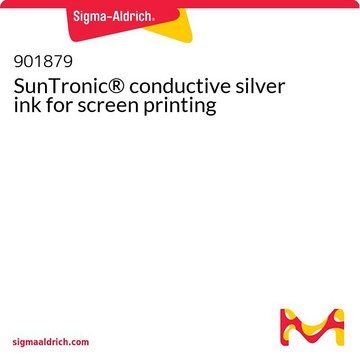791512
Platinum paste, screen printable
Synonym(s):
Greatcell Solar PT1 platinum paste, Pt paste, conductive paste
About This Item
Recommended Products
form
paste (Amber)
Quality Level
viscosity
2500-4500 mPa.s (Analysis carried out at 20°C with 20mm 4 degree cone/plate; 40 s-1)
storage temp.
2-8°C
InChI
1S/Pt
InChI key
BASFCYQUMIYNBI-UHFFFAOYSA-N
Related Categories
Application
PT1 Platinum Paste is oil-based and formulated to be applied using a screen printer; providing films with excellent uniformity; performance and reproducibility; and can be used for DSSC polot production.
After drying; this paste must be fired at or above 420°C. This results in uniformly distributed platinum nanoclusters; providing good transparency and high catalytic activity for the electrochemical reduction of I3- to I-.
Suggested Mesh Screen: 100T
Legal Information
Greatcell Solar is a registered trademark of Greatcell Solar Materials Pty Ltd
Signal Word
Danger
Hazard Statements
Precautionary Statements
Hazard Classifications
Eye Dam. 1 - Resp. Sens. 1 - Skin Irrit. 2 - Skin Sens. 1
Storage Class Code
10 - Combustible liquids
WGK
WGK 1
Flash Point(F)
194.0 °F
Flash Point(C)
90 °C
Choose from one of the most recent versions:
Already Own This Product?
Find documentation for the products that you have recently purchased in the Document Library.
Customers Also Viewed
Articles
Dye-sensitized solar cells (DSCs) are 3rd generation solar cells combining the promise of high efficiency with low production costs.
While dye sensitization as the basis for color photography has been accepted for a very long time,1 attempts to use this principle for the conversion of solar light to electricity generally had resulted only in very low photocurrents, below 100 nA/cm2.2
Professor Tokito and Professor Takeda share their new materials, device architecture design principles, and performance optimization protocols for printed and solution-processed, low-cost, highly flexible, organic electronic devices.
Recent progress in the area of solution-processed functional materials has led to the development of a variety of thin-film optoelectronic devices with significant promise in the industrial and consumer electronics fields.
Our team of scientists has experience in all areas of research including Life Science, Material Science, Chemical Synthesis, Chromatography, Analytical and many others.
Contact Technical Service












